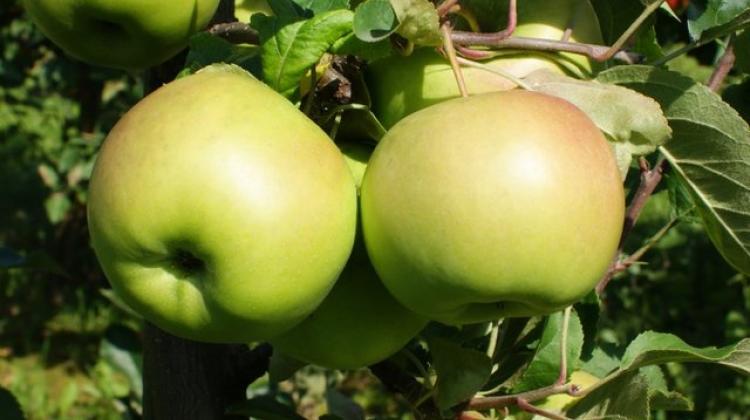New apple variety bred by SGGW-WULS
 Apples of the "Chopin" variety. Source: SGGW-WULS
Apples of the "Chopin" variety. Source: SGGW-WULS
A new apple variety called "Chopin" was bred at the Warsaw University of Life Sciences (SGGW-WULS). It is resistant to scab, which allows to significantly reduce the scope of chemical treatments - university spokesman Krzysztof Szwejk told PAP.
One of the main directions of research conducted at the Faculty of Horticulture, Biotechnology and Landscape Architecture is breeding new apple varieties. The greatest breeding achievement is the "Chopin" variety registered as the property of SGGW-WULS. Currently, trees of this variety are grown in SGGW-WULS nurseries of and Ryszard Nowakowski nurseries (ARNO, Lewiczyn) and sold to interested fruit farmers. Fruits should appear on the market in 3-4 years - said the SGGW-WULS spokesman.
According to Prof. Kazimierz Tomala from the Department of Pomology SGGW-WULS, the variety "Chopin" has many beneficial traits that make it attractive for fruit growers, consumers, as well as produce makers. First of all, it is resistant to scab (fungal disease of apple trees), thanks to which it requires a much smaller number of chemical treatments, possibly even none. For this reason, these apple trees are suitable for amateur and organic farming.
Compared to other scab-resistant varieties, "Chopin" also has very long shelf life after harvest (6-7 months), while most varieties of this type are autumn or early winter varieties, which can not be stored for too long.
According to the professor, the fruits of this variety have a high biological value and are perceived by consumers as tasty, crisp and juicy. "Chopin" apples contain a lot of organic acids, due to which just after harvest they can be perceived as excessively bitter. However, in the maturing process their taste changes to a sweeter one.
The bitter taste of the variety is a great advantage for the processing industry, because sweet varieties dominate the market. More bitter apples of the "Chopin" variety can be an attractive ingredient in the production of juices and ciders. They can also be used to produce delicious chips and apple pie mousses - noted Prof. Tomala.
The professor emphasised that new apple varieties are very important for the development of fruit growing, because each variety has a limited time of efficient yielding. In addition, varieties differ in susceptibility to disease, requirements concerning position and cultivation technology, as well as fruit size. To maintain the size and quality of production, old trees need to be replaced with new ones.
The second reason for growing new varieties is the need to adapt to the tastes of consumers. And those are different in every country. For example, customers in the Persian Gulf countries prefer uniformly coloured apples, for example red or yellow, while in Western Europe ribbed froits are becoming more popular - explained the professor. Fruit farmers decide to exchange varieties also for economic reasons, when the production of apples of certain variety becomes less profitable.
Researchers have an increasing amount of knowledge of the different nutrients contained in fruits and vegetables, and they can also develop varieties that have these desirable substances in higher amounts. Scientists at WULS-SGGW are working on obtaining red-pulp fruit, characterized by a higher biological value due to the high content of compounds acting as scavengers of free radicals.
Many people have a fondness for old apple varieties. But - according to Tomala - it results from the fact that decades ago apples were seasonal fruits and almost a luxurious product. Hence, we idealize everything that comes from old times. Currently, apples of varieties "Kosztela" or "Malinówka" are rarely found in stores, but are not very popular among consumers either. Those who buy them admit that they are not as tasty as they used to be.
Poland is the third world producer of apples. Last year (according to the Polish Statistical Office), 3.6 million tonnes were collected, this year it is estimated that about 3 million tonnes will be obtained. China (43 million tons) and the US (5 million tons) have a much bigger production. About 25 percent domestic production will be exported. (PAP)
PAP - Science in Poland
author: Anna Wysoczańska
editor: Marek Michałowski
awy/ maro/ kap/
tr. RL
Przed dodaniem komentarza prosimy o zapoznanie z Regulaminem forum serwisu Nauka w Polsce.















